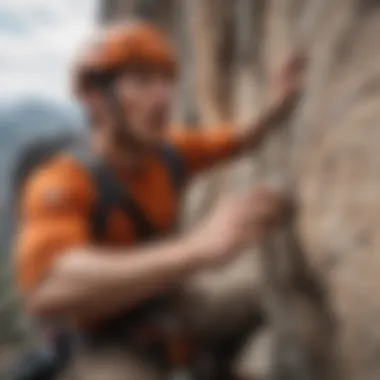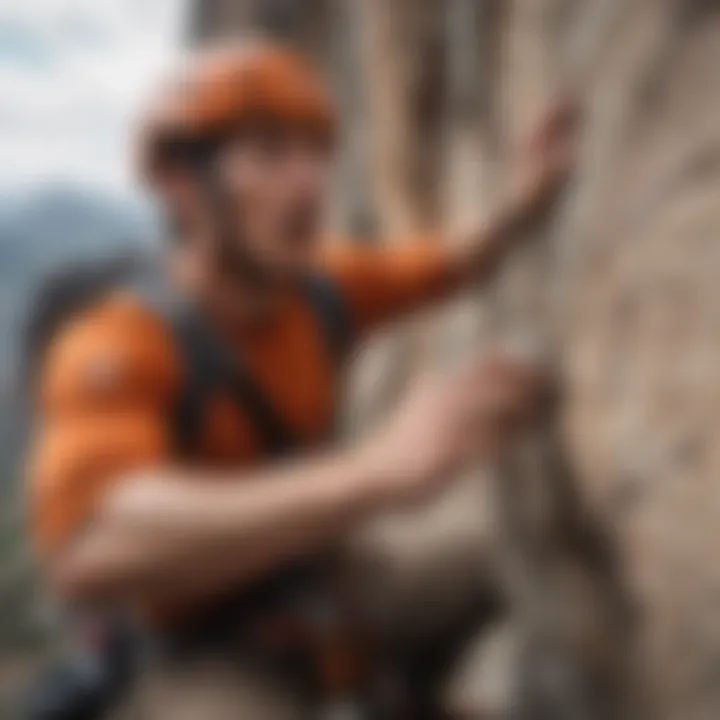Breath Holding Exercises in Extreme Sports


Intro
In the realm of extreme sports, where adrenaline rules and the stakes are often high, the art of breath control can significantly enhance performance. Breath holding exercises might sound simple, but they wield a surprising amount of power. Whether you’re surfing monstrous waves or scaling sheer rock faces, having command over your breath can mean the difference between success and struggle.
In recent years, athletes have begun to realize that mastering their breathing not only boosts their physical capabilities but also enhances mental focus. Just like any skill, practice is key. But what does that practice look like? What techniques should be employed? This guide dives deep into the significance of breath holding exercises—unpacking their physiological benefits, sharing practical methods, and shining a light on common pitfalls to steer clear of.
Consider this your roadmap to unlock your full potential in high-adrenaline pursuits. Let’s take a closer look at the techniques and tips that will elevate your game.
Techniques and Tips
Skill Development
To effectively use breath holding exercises in your training, it’s crucial to develop your skills progressively. Start with shorter holds and gradually increase the duration as your body becomes accustomed. Here’s a step-by-step outline:
- Begin with Relaxation: Before starting, find a calm space where you can concentrate. Lie down or sit comfortably and take a few moments to let your body relax.
- Practice Diaphragmatic Breathing: This involves taking deep breaths from your belly rather than shallow ones from your chest. Place one hand on your chest and the other on your belly. Your belly should rise more than your chest.
- Gradual Holds: Start with holding your breath for 10 seconds, breathing normally between holds. Increase by 5-10 seconds until you can comfortably hold for longer durations.
Practical Techniques
There are several techniques that athletes can incorporate into their training:
- Static Apnea: This involves holding your breath while either floating in water or sitting still. It’s an effective method to increase your lung capacity.
- Dynamic Apnea: Here, you swim underwater for as long as you can without breathing. This is particularly useful for divers and surfers.
- Box Breathing: Some athletes favor the box breathing method, where you inhale for a count of four, hold for four, exhale for four, and hold out for four. It helps in enhancing mental clarity and relaxation.
Common Mistakes to Avoid
As with any new skill, one can easily fall into traps that hinder progress. Here are a few common mistakes:
- Skipping Warm-Up: Always warm up before breath holds. Skipping this can lead to discomfort or even fainting.
- Holding Breath Too Long: While it’s commendable to push limits, overextending can be dangerous. Listen to your body.
- Ignoring the Flushing Phase: Remember that it’s not just about holding your breath. Pay attention to the exhale phase to properly flush out carbon dioxide.
"Breath is the bridge which connects life to consciousness, which unites your body to your thoughts." - Thich Nhat Hanh
By focusing on skill development, employing practical techniques, and avoiding prevailing mistakes, even those new to extreme sports can enhance their breath control skills.
Gear and Equipment
Essential Gear for Beginners
Entering the world of breath holding exercises doesn’t require fancy gear; however, investing in a few essentials can elevate your experience:
- Swim Goggles: A pair of quality goggles can help you see clearly underwater while practicing dynamic apnea.
- Breath Hold Timer: A simple stopwatch or timer app can assist in tracking your progress and durations.
- Comfortable Clothing: Loose-fitting clothes help minimize discomfort, especially when practicing breathing techniques.
Latest Innovations and Trends
As more athletes recognize the benefits of breath control, innovative tools are emerging:
- Mobile Apps: There are various apps designed to guide users through breath-holding exercises and monitor lung capacity.
- Wearable Tech: Devices that track breathing patterns can offer feedback that helps in fine-tuning your technique.
Reviews and Comparisons
Finding the right gear can feel daunting. Checking user reviews on forums like reddit.com can provide valuable insights. Consider platforms that have both expert opinions and user experiences for well-rounded information.
Safety Measures
Essential Safety Gear
Safety should always be paramount. While breathing exercises might seem non-threatening, certain measures can enhance overall safety:
- Buddy System: Always practice with a partner, especially during underwater exercises. They can assist in case you lose consciousness.
- Safety Buoy: If practicing in open water, a buoy can help keep track of your position and signal others.
Best Practices for Safe Participation
Incorporating some best practices will ensure a safer experience:
- Know Your Limits: It’s easy to get caught up in the thrill and push yourself beyond safe boundaries.
- Environment Awareness: Understand the environment you are training in, especially currents, waves, or altitude variations.
Injury Prevention and Management


Like any physical endeavor, there exists the risk of injury:
- Proper Breathing Technique: Neglecting correct techniques can lead to hyperventilation or even blackouts.
- Post-Exercise Stretching: Always conclude with stretches to prevent muscle strain and enhance recovery.
By adopting these safety measures, athletes can enjoy the exhilarating world of extreme sports while prioritizing their well-being.
Spotlights on Extreme Sports
Featured Sport of the Month
Each month, a unique extreme sport will be highlighted. This month, let’s put the spotlight on freediving—a sport that beautifully intertwines breath holding techniques with an exhilarating underwater experience.
Profiles of Prominent Athletes
Highlighting inspiring figures can motivate others to explore the nuances of breath control:
- Umberto Pelizzari: A legend in the world of freediving known for his incredible lung capacity.
- Natalia Molchanova: Renowned for her record-breaking dives and remarkable contribution to the sport.
Through these insights, athletes can draw inspiration and knowledge, preparing them for their next extreme challenge.
Prelude to Breath Holding Exercises
Breath holding exercises represent a unique and vital aspect of training for anyone engaged in extreme sports. Whether you’re riding the tumultuous waves of the ocean, scaling jagged cliffs, or plunging depths free of any equipment, your breath plays a pivotal role in your ability to perform. It’s not just about gasping for air; it’s about harnessing control over your body’s most basic function to unlock new levels of endurance and focus.
Understanding the Basics of Breath Control
At the core of breath holding exercises is the idea of breath control, which entails both the ability to hold your breath and manage the rhythm of your breathing. This concept bifurcates into two main forms: static and dynamic control. Static breath control allows individuals to remain motionless while holding their breath, fostering an awareness of one’s limits and increasing the time one can endure without oxygen. Dynamic breath control, conversely, is pursued through active movement. In extreme sports, this is often simulated during physical exertion, where the adrenaline rush can heighten the body's response to breath-related challenges.
Mastering these techniques facilitates not just enhanced performance but also a more profound connection between mind and body. Athletes note that as they engage in breath control, they develop a heightened sense of awareness regarding their physical state. This awareness translates into better decision-making in fast-paced, challenging environments, making breath control a cornerstone of training for the adventurous.
The Relevance to Extreme Sports
The relevance of these exercises in extreme sports cannot be overstated. In environments where each second counts and reactions must be swift, controlled breathing can be the difference between success and failure. For example, in freediving, athletes must withstand significant physical stress while remaining calm to avoid panic, which can quickly spiral into dangerous situations.
Here’s how breath holding feeds into various extreme sports:
- In Surfing: A surfer must duck dive under waves, often holding their breath while navigating turbulent waters. The ability to control one’s breath can lead to improved underwater mobility and comfort during these moments.
- In Rock Climbing: Staying calm under pressure is essential when scaling heights. A climber’s ability to manage breathing not only helps with endurance but can also enhance focus, reducing the risk of missteps.
- In Freediving: Holding one’s breath efficiently during dives allows for deeper exploration and longer underwater durations.
Numerous athletes express that consistent practice of breath holding exercises has led to improvements not just in their physical capabilities but in mental fortitude.
"Breath is the bridge between the body and the mind. By mastering it, you control both."
In sum, understanding and practicing breath holding exercises opens doors to new realms of performance within extreme sports. Athletes who prioritize these exercises are not just training their bodies; they are cultivating a unique resilience that prepares them for the unpredictable challenges of the extreme sports landscape.
Physiological Mechanisms of Breath Holding
Understanding the physiological mechanisms underlying breath holding is crucial for extreme sports enthusiasts. This knowledge not only enhances performance but also provides insights into how our bodies interact with oxygen and carbon dioxide. Being aware of these mechanisms can help athletes develop strategies that align their physical condition with their performance demands, especially during high-stakes situations like climbing steep cliffs or riding massive surf waves.
Oxygen Consumption and Utilization
When you hold your breath, your body adapts in fascinating ways regarding how it consumes and utilizes oxygen. Essentially, oxygen consumption refers to how much oxygen your muscles need to perform effectively. When breath holding is practiced, it fundamentally alters the balance of oxygen and carbon dioxide in the body.
- Initial Stage: Initially, when you hold your breath, your body starts to use up the stored oxygen. If you’re not careful, this can lead to a rapid onset of fatigue, making it difficult to maintain performance.
- Adaptation Phase: With regular practice, your body becomes more efficient at utilizing the available oxygen. Muscles learn to operate in a low-oxygen state, which can be beneficial in extreme sports where environmental factors might limit oxygen availability.
Athletes engaged in activities like freediving and motocross can benefit significantly from increased oxygen utilization, fostering endurance and performance gains.
The Role of CO2 Tolerance
Next up, let's talk about CO2 tolerance. When you hold your breath, carbon dioxide accumulates in your bloodstream. The body's response to this build-up is critical and can dictate both comfort and performance levels.
- Importance of Tolerance: Increased CO2 levels lead to urges to breathe, which can be uncomfortable. However, developing a high tolerance for CO2 allows athletes to push through moments of discomfort. This can result in longer breath holds, providing extra time to perform tasks, especially underwater or while navigating rugged terrains.
- Training for Tolerance: Techniques such as resistance training and interval exercises can enhance CO2 tolerance. Practices might include static breath holds or incorporating breath holds into physical workouts. These adaptations promote greater resilience, allowing athletes to handle physically taxing situations without succumbing to panic.
Effects on Heart Rate and Blood Flow
Finally, it’s worth noting how breath holding impacts heart rate and blood flow. When you hold your breath, your heart rate typically decreases, a phenomenon known as the diving response.
- Diving Reflex: This reflex triggers a series of changes: heart rate slows, peripheral blood vessels constrict, and blood flow is redirected towards essential organs. For those involved in extreme sports, this physiological reaction can enhance concentration and performance under pressure.
- Adaptive Advantage: Ensuring that blood is prioritized to critical areas enhances endurance and can lead to improved overall physical performance during activities such as surfing or skiing.


In summary, understanding the physiological mechanisms of breath holding not only helps in honing the body’s performance but also equips extreme sports athletes with necessary skills to face challenges head-on. By enhancing oxygen utilization, increasing CO2 tolerance, and recognizing the effects on heart rate and blood flow, athletes can maximize their potential and embrace the thrills of their chosen adventures more fully.
Techniques for Effective Breath Holding
When it comes to extreme sports, mastering breath holding can be as crucial as honing your physical skills. The ability to control your breath not only enhances performance but also contributes to your safety in high-stress situations. Whether you're riding a wave or scaling a cliff, effective breath-holding techniques can provide that extra edge, allowing for prolonged exertion without succumbing to fatigue or fear.
Static Apnea Exercises
Static apnea involves holding your breath while remaining still, making it an excellent method for building your breath control skills. Think of it as practicing the art of stillness—where both your body and mind harmonize.
- Find a Comfortable Spot: Select a calm location, free from distractions. This could be an indoor pool or a quiet corner at home.
- Warm-Up: Start with some gentle breathing exercises; inhale deeply, hold for a few seconds, and exhale slowly. This prepares your body for what’s coming.
- Gradual Interval Increases: Begin by holding your breath for shorter intervals, increasing the duration as your comfort grows. It’s like training a muscle; push it just a bit more each session.
- Relaxation is Key: As you hold, focus on relaxing your body. Tension can lead to early fatigue, so embody that stillness.
Not only do static apnea exercises enhance lung capacity, but they also serve to develop a deeper mental focus—a critical attribute in extreme sports where distractions can spell danger.
Dynamic Apnea Exercises
Dynamic apnea takes things up a notch, incorporating movement while holding your breath. This is where you’ll find practical applications suited for the context of extreme sports. Consider the following:
- Fluid Movement: Use your body wisely. Glide through water, swim, or traverse short distances without oxygen. Your goal is to navigate your environment while managing your breath—a skill set that mirrors the demands of surfing or free diving.
- Breath Timing: Pay attention to when you inhale before starting the exercise. Capturing the optimal moment enhances performance, especially underwater or during a challenging climb.
- Incremental Challenges: Start small; try covering short distances first, gradually increasing as your confidence builds. It’s essential to honor the limits of your body while also pushing those boundaries responsibly.
This technique makes a world of difference in sports where periods of high exertion can lead to breathlessness. Practicing dynamic apnea not only maximizes endurance but also trains your mind to stay calm under pressure.
Integration with Meditation and Mindfulness
Linking breath holding with meditation introduces an enriching layer to your training. The practice instills a greater awareness of your body and mind alignment, a crucial advantage when faced with extreme conditions. Here’s how you can weave these elements together:
- Mindful Breathing: Begin with a focused meditation session where your sole task is to observe each breath. This slow, intentional breathing lays the groundwork for understanding your body’s natural rhythms.
- Visualization Techniques: As you meditate, visualize yourself in your extreme sport of choice. Imagine each breath fueling your performance, fostering a mental connection between breath control and success.
- Consistent Practice: Make mindfulness a habit. Just as with static and dynamic apnea exercises, regular meditation reinforces your resilience. It encourages you to center yourself in high-pressure scenarios, making it easier to draw from your breath reserve when you need it the most.
"Breath is the bridge which connects life to consciousness, which unites your body to your thoughts." — Thich Nhat Hanh
Using breath holding as a foundation for meditation not only enhances physical performance but also contributes to a more holistic understanding of oneself as an extreme sport enthusiast, enabling you to face challenges with poise and fortitude.
The Mental Aspect of Breath Control
When it comes to extreme sports, the physical prowess of athletes is only part of the equation. The mental component, particularly breath control, cannot be brushed aside. Why is this mental aspect pivotal? Because it acts as a bridge between physical capabilities and peak performance. It is one thing to be fit; it's another to harness that fitness under pressure, especially in techniques requiring breath holding, such as surfing or freediving. Managing your breath helps maintain composure and confidence in the face of exhilarating challenges, where every second could make the difference.
Building Mental Resilience Through Breath Exercises
Breath exercises serve as not just a method for enhancing performance but also as a vehicle for building mental toughness. They require focus and discipline, which in turn fosters resilience. By incorporating breath-holding techniques, athletes learn to push through discomfort and uncertainty. The practice can become a mental training ground: when one can stay calm under duress, the same composure carries over during high-stakes situations, be it battling towering waves or scaling a rock face.
Consider this: during a challenging climb, the ability to control your breath can radically alter your experience. You might face fear or anxiety as fatigue sets in. However, those who practice breath-holding find themselves adept at grounding their thoughts and maintaining steadiness. Small successes in these exercises stack up, reinforcing a mindset that not only accepts challenge but thrives in it.
"Breath control shapes the mind just as it shapes the body."
The Connection Between Breath and Focus
Focusing ahead is essential in extreme sports. The clarity of thought is often clouded by adrenaline and stress. This is where breath control comes into play. Many athletes report that by regulating their breathing, they can clear mental clutter. Breath anchors them in the moment, allowing them to assess their surroundings and make swift, informed decisions.
In surfing, for instance, when waiting for the right wave, controlled breathing can lead to serene alertness. This mental clarity opens channels of focus that can often feel obscured during intense moments. The rhythmic inhale and exhale creates a meditative state. In this state, athletes become more attuned to the signals from their bodies and the environment, improving not only performance but also safety.
Here’s a simple exercise to illustrate this connection: when preparing for an event, take a few minutes to focus on exhaling slowly. Count to five while you breathe out, and feel the tension fade away. This doesn’t just manage breath—it refines focus, connecting your mental and physical faculties.
Applications in Specific Extreme Sports
Breath holding exercises might seem niche, yet their relevance in extreme sports is profound. Athletes in fields such as surfing, rock climbing, and freediving can greatly benefit from incorporating breath control into their training regimes. Mastering breath holding can enhance performance, increase safety, and sharpen mental acuity during intense physical challenges. It's about harnessing the power of breath as a tool, not just for survival, but for transcendence in the face of extreme conditions.
Surfing: Navigating the Waves with Controlled Breathing
For surfers, understanding and managing breath is not merely a biophysical necessity; it’s a lifeline. When you’re riding those towering waves, aligning your breath with the rhythm of the ocean is crucial. Control over breath allows for better timing when catching a wave, helping to maintain composure and reduce panic in critical moments.
- Take advantage of breath patterns. Practicing breath holding can enhance your lung capacity. By learning how to manage breath, surfers can make those critical moments last longer, avoiding excess oxygen consumption during intense rides.
- Mind over Matter. Surfing is as much mental as it is physical. Calm, focused breath helps to clear the mind, minimizing distractions from fear or doubt. When a surfer becomes attuned to their breath, they can concentrate better on their movements and the ever-changing dynamics of the sea.
Studies show that athletes who practice controlled breathing techniques report significantly improved performance metrics.
Rock Climbing: Enhancing Endurance and Focus


In rock climbing, breath control takes on a different form but is no less significant. As climbers scale heights, they encounter not just physical obstacles but psychological challenges as well. Controlled breathing helps in maintaining calm under pressure.
- Reducing physical fatigue. A steadied breath makes a climber more efficient. By oxygenating muscles better and delaying fatigue, climbers can push through tough sections of their climb without losing energy.
- Focus and concentration. In those moments where every grip counts, breath holds can ground a climber’s focus. It transforms a chaotic ascent into a series of controlled movements, enhancing overall stability on challenging terrain.
Freediving: Pushing the Limits of Breath Holding
Freediving takes breath control to the extreme, quite literally. The sport centers around the art of diving deep without breathing apparatus, relying solely on the diver's ability to hold their breath. In this context, breath holding is paramount for success and safety.
- Economy of air. Freedivers learn the importance of managing air consumption. Effective breath holding allows them to explore greater depths while minimizing the risks associated with shallow water blackout.
- Psychological preparation. Mental resilience is key. Freedivers engage in breath holding exercises to develop not just physical capabilities but also the psychology needed to manage stress and anxiety associated with long dives. Through repetitive practice, they train their minds to handle the depths with calm and focus.
Overall, the applications of breath holding in these sports highlight its essential role in optimizing performance. Recognizing the intersections between breath control and peak athletic ability can transform aspiring adventurers into seasoned competitors, all while fostering a deeper connection with their chosen pursuits.
Safety Considerations and Best Practices
Engaging in breath holding exercises can be both exhilarating and beneficial for extreme sports enthusiasts. However, to fully reap the rewards, it’s crucial to consider safety measures. Misjudgments or lack of caution can lead to serious consequences, making safety the keystone of a successful practice. This section focuses on the core elements and benefits of adopting a safety-first mindset while navigating breath control techniques.
Educating About Risks and Precautions
When it comes to breath holding, knowledge is power. Understanding the risks involved is the first step in mitigating them. Breath holding, while beneficial, can lead to symptoms such as dizziness, fainting, or in severe cases, loss of consciousness. Here are some vital precautions:
- Practice in Safe Environments: Always train in settings where help is readily available, particularly when starting out.
- Avoid Hyperventilation: Over-breathing before a breath hold can decrease carbon dioxide levels rapidly. This may lead to shallow breathing and can be dangerous.
- Stay Hydrated: Proper hydration supports overall bodily functions, ensuring that your body can respond effectively to intense physical activities.
- Train with a Partner: If possible, practice with someone who can assist or provide guidance, especially during static apnea exercises. This ensures there’s someone to help in case of unexpected situations.
Educating yourself and those around you on these risks ensures that everyone involved in breath holding practice remains vigilant.
"Before we dive into the depths, we must first learn to breathe with intention."
Setting Realistic Goals for Improvement
As you venture into the realm of breath holding, setting goals is paramount. It's tempting to push the limits right from the get-go, but taking it slow can lead to authentic growth. Here are some strategies to help you along the way:
- Assess Your Current Ability: Take the time to understand your baseline. How long can you comfortably hold your breath? Knowing this allows you to set achievable targets.
- Incremental Progressions: Instead of shooting for a dramatic increase, set smaller, measurable goals. Perhaps aim to extend your breath hold by a few seconds each week. This method respects your body’s limits while promoting continuous development.
- Combine Goals with Other Techniques: Integrating breath holding exercises with other training regimens—such as dynamic apnea or meditation—can provide a more rounded improvement in your physical capacities.
- Celebrate Achievements: Big or small, it’s essential to recognize your progress. This keeps motivation high and encourages a long-term commitment to breath holding.
In its essence, breath holding is not just about holding the breath; it’s about cultivating an attitude of patience and awareness. Setting your sights on realistic milestones fosters a healthier relationship with this practice while underscoring the importance of safety.
Measuring Progress in Breath Holding
Measuring one's progress in breath holding can be akin to charting the course of a complex journey; it’s vital for understanding not just how far one has come, but also the distance left to travel toward mastery. This process isn’t just about clocking seconds; it’s about comprehending the subtleties of your body’s responses, achieving incremental improvements, and ultimately transforming those small victories into significant performance gains. For extreme sports enthusiasts, effective tracking can make the difference between a mediocre outing and a stellar performance, pushing boundaries where every moment counts.
Methods for Tracking Improvement
Several effective methods exist for tracking improvement in breath holding skills, each providing unique insights:
- Timely Logs: Maintaining a log that tracks each session’s times and conditions can help identify trends in your performance over days, weeks, or months.
- Breath Holds Under Different Conditions: Testing your ability to hold your breath in various environmental settings—like at sea level versus higher altitudes—can reveal how external factors influence your capacity.
- Comparison Against Past Runs: Recording personal bests and comparing them against previous attempts allows you to gauge progress effectively.
- Physiological Measurements: Using tools like heart rate monitors can provide additional context to your breath-holding sessions. Monitoring heart rate during these exercises can signal improvements in cardiovascular fitness.
These methods don't just add numbers; they contribute to a broader understanding about how one's body reacts under stress and builds resilience over time.
Feedback Mechanisms for Continuous Growth
Receiving feedback during training isn't merely helpful; it’s crucial. With extreme sports, where stakes are incredibly high, ongoing assessments serve multiple purposes:
- Structured Coaching: Working with experienced coaches who specialize in breath control can provide personalized feedback that is vital for refining techniques and correcting flaws in execution.
- Peer Review: Engaging with like-minded enthusiasts—perhaps through communities on platforms like Reddit or Facebook—allows for shared experiences and constructive insights.
- Self-Reflection: After each session, take time to reflect on what worked and what didn’t. Journaling these thoughts can lead to breakthroughs in your technique or mindset.
- Video Analysis: Recording your sessions can reveal subtle aspects of form or technique that might be missed in real-time. Watching back with a critical eye can spark corrections and adjustments.
"Progress isn’t always a straight line; sometimes it looks more like a mountain trail, with ups and downs, but every step forward counts."
Integrating systematic tracking and feedback into your breath holding practices forms the cornerstone of continuous improvement. It promotes not only a deeper understanding of personal capabilities but also heightens the thrill and enjoyment that comes from pushing boundaries in extreme sports.
Epilogue: Breath Holding as a Tool for Enhancing Performance
As we bring our discussion on breath holding exercises to a close, it’s essential to underscore their significance in extreme sports. Breath control is as much about technique as it is about psychological fortitude. Mastering this skill can translate directly into enhanced performance, enabling athletes to thrive in daunting conditions.
Summarizing the Benefits
Breath holding exercises offer a plethora of benefits that could potentially change the game for many athletes.
- Enhanced Oxygen Efficiency: The body learns to utilize oxygen more effectively, which is crucial during high-stakes activities when every breath counts.
- Increased CO2 Tolerance: By regularly practicing breath control, athletes can improve their body’s tolerance to carbon dioxide, delaying fatigue during intense physical exertion.
- Mental Clarity and Focus: The concentration required during breath holding can sharpen an athlete's focus, allowing for better performance in high-pressure environments.
- Physical Resilience: Consistent training fosters both physical strength and mental toughness, key attributes in challenging conditions associated with extreme sports.
"In the end, it’s all about mastering the breath. The moment you control your breath, you gain control over your performance."
Looking Ahead: Future Research and Practices
It’s worth contemplating where the journey of breath holding exercises might lead us in the future, particularly as scientific research continues to advance.
- Integration with Technology: The advent of wearables may provide real-time feedback on breath patterns, helping athletes refine their techniques.
- Diverse Techniques and Methods: There’s a world of breath control disciplines, from yoga to free diving. Future research could explore the synergy between these practices and high-performance sport.
- Tailored Training Regimens: Customized breath holding techniques designed for specific sports may emerge, allowing athletes to enhance performance in a more focused manner.
- Greater Public Education: Increased awareness of the benefits of breath control might lead to widespread adoption among not just athletes, but the broader fitness community.







